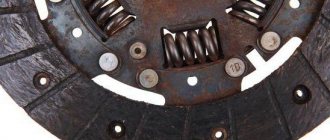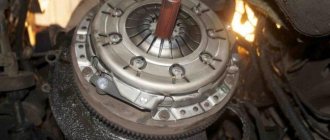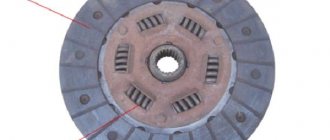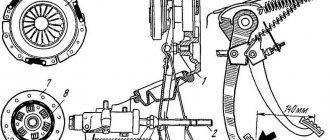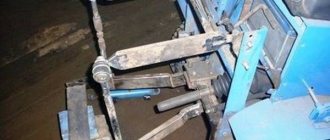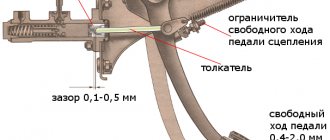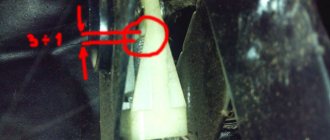Hi all! Clutch failure does not bode well for the car and its owner. The sooner signs of problems can be detected, the better. A fairly common question on this topic is why the clutch slips or slips. Different terminology is used, but the essence remains the same.
It is important to understand that modern cars use dry and wet, also known as oil, clutches. In the first case, we are talking about simple friction, while in the second, the procedure is carried out in a special oil, which additionally cools the clutch discs and other elements. Most often we encounter the dry type. Wet is used on cars with dual clutch and robotic gearboxes. It is difficult to adjust and repair a wet clutch with your own hands. This requires the help of specialists.
The most common sign of unit malfunction is slipping. Moreover, for some it happens constantly, while for others it sometimes stalls, sometimes not. This can happen both hot and cold, that is, before and after the unit warms up.
How the problem manifests itself
Most often, the cause of clutch slipping is normal mechanical wear of the assembly elements. This allows you to diagnose an impending problem even before serious consequences appear. This is done by simply observing changes in the behavior of the machine.
If you notice one of the following signs on your Niva, passenger car or scooter, be sure to diagnose the clutch or contact a service center.
- Extraneous sounds occur during system operation. They appear in the form of knocking noises when the pedal is depressed or released;
- If the noise disappears when the clutch pedal is depressed, the problem is most likely in the release bearing;
- There are signs of vibration on the pedal;
- In this case, the pedal may sink too much or be pressed too hard;
- A characteristic burning smell emanates from the clutch. The clutch usually burns if the driver operates it incorrectly.
The manufacturer provides each vehicle with instructions that indicate all recommendations for routine maintenance and replacement of clutch assembly elements. Most often, the driven disk needs to be replaced.
Before you try to adjust the system yourself, be sure to familiarize yourself with the principle of operation of the clutch. In our previous article we discussed this issue.
Why does the clutch slip only under certain conditions?
The reasons why the clutch slips at high speeds, when accelerating or after the car has been idle, are different. The most common of them:
Characteristic signs of clutch wear
- incorrect installation or configuration;
- ambient temperature;
- aggressive driving style;
- heavy load (for example, trailer);
- natural wear and tear of parts.
If disc slipping occurs only in certain conditions, for example, when it’s cold, the clutch slips in 3rd and 4th gear, or if you change the clutch and it slips, then identifying a specific malfunction should consider the options that will be discussed below. All the main symptoms and causes of transmission slipping are presented in the table.
| Problem | Cause | What to do |
| Clutch slips when cold or in winter | A cold clutch disc is already hot. When heated, bodies tend to expand, so the heated disk begins to press harder against the also heated basket and flywheel. | If the clutch slips when cold, you can drive it, but you shouldn’t put off repairs too much, as this is usually a sign of large deterioration of the friction surfaces. |
| Water (snow) got into the checkpoint bell. | if the clutch slips in the cold due to water getting in, you just need to let it warm up and dry | |
| Clutch slips when hot | When heated, the friction force decreases, so the hot clutch slips and cannot transmit high torque from the engine to the gearbox. | If the clutch slips at speed after warming up, it must be changed, since due to constant heating the defect will quickly progress. in the case of a “wet” clutch with an oil bath (usually used on DSG “robots” and the like), you first need to check the amount of lubricant; perhaps it’s just a lack of oil. |
| clutch slips after crossing a ford or large puddles | if after fording, driving through mud and puddles or in heavy rain the clutch slips, the friction discs have become wet/contaminated | you need to disassemble and clean the clutch parts. To prevent contamination, do not depress the clutch while in water or mud. |
| Clutch slips after repair | the details didn't fit in | check the adjustment, break in the clutch |
| incorrect drive adjustment | adjust the clutch release mechanism | |
| incorrect assembly | inspect the clutch for correct assembly, check with the instructions, assemble correctly | |
| incompatibility of components or wear of old parts | if the clutch slips after replacing its individual parts (for example, the disc is new, but the basket is old), check whether the parts fit together and whether the old parts are overused | |
| New clutch slips | incorrect adjustment (basket pinched) | check the adjustment, loosen the basket pressure |
| incorrect assembly | check the correctness of assembly, assemble correctly | |
| incompatible parts selected | check new and old parts, their articles, if identified |
If there is clutch slipping caused by improper adjustment or lack of oil (for wet-type systems), it is important to immediately correct this problem. Otherwise, the disks will constantly overheat, wear out quickly and repairs will be much more expensive!
Possible consequences
A slipping clutch is a fairly common occurrence. This is especially true for domestic cars, motorcycles and cars with high mileage.
Practice and experience clearly show that slipping is usually associated with wear and damage to elements. This can happen on any car or other vehicle. Judging by the requests of fans of self-repair, most often the problem of a slipping clutch is solved on the following vehicles:
- VAZ 2107;
- VAZ 2114;
- IZ Planet;
- UAZ Bukhanka;
- Jupiter;
- KAMAZ;
- Minsk;
- VAZ 2110;
- Renault Logan;
- Kia Rio;
- Lada Priora;
- GAZelle, etc.
Despite the obvious cause of such problems, many car owners stubbornly continue to ignore all recommendations for maintenance and timely repair of the unit.
If you feel characteristic signs of problems, you should take prompt action.
When buying a used car or getting behind the wheel for the first time, some people think that they are simply driving the vehicle incorrectly, are not yet fluent in manual shifting techniques and are making some mistakes. In reality, it may turn out that the clutch is failing.
It is important to pay attention to the characteristic signs. Namely:
Causes of clutch slipping
Clutch wear occurs directly at the moments of closing and opening the discs, when there is their mutual slipping, that is, it is always associated with starting off and changing gears.
If the car continuously moves along a country road without interference, populated areas and traffic lights, then the clutch will turn from a consumable into an eternal unit that will last longer than the engine or car body.
On topic: How to bleed a car’s clutch yourself
Slipping can be considered normal when it stops when the pedal or rod is completely released, and also a sign of complete wear if the discs continue to slip when engine torque increases, despite the complete removal of force from the release bearing.
Abuse of incomplete squeezing
In addition to its main function, that is, breaking the connection between the engine flywheel and the gearbox input shaft, the clutch is capable of transforming the gear ratio within certain limits.
For example, when starting off, the wheels, and therefore the input shaft of the box, are motionless. It is impossible to apply engine torque to them without slipping, since an internal combustion engine is not an electric motor, and its torque at zero speed is also zero.
The crankshaft must be untwisted until an acceptable torque value is obtained, it must be applied to the clutch driven disc, after which the clutch will slip until a certain speed is reached.
This mode is completely normal, but it can be abused, that is, it can unreasonably prolong the slipping time:
- when trying to start as smoothly as possible and lacking experience;
- when starting from second or higher gear instead of the intended first;
- compensating for the lack of traction capabilities of the car by incomplete engagement of the clutch;
- just keeping your foot on the pedal without thinking about the consequences.
In this case, the clutch overheats, wears out quickly and begins to slip during normal driving, especially in higher gears, when the torque on it is maximum.
Contamination of friction discs
Dirt on the driven disk linings can appear for various reasons:
- burning of the linings after a long slip;
- driving with deep immersion in water and mud;
- ingress of lubricant during replacement of parts due to negligence;
- leaking engine and gearbox seals.
The clutch is rarely made with a large margin of force of the working spring, so the slightest contamination of the discs and flywheel, which leads to a drop in the coefficient of friction, will certainly lead to a slippage when trying to transmit the maximum engine torque.
Severe wear on the linings
The driven disc linings are made of a special material that has a high coefficient of friction against steel, but is also quite soft.
It wears out due to slipping, the thickness of the disk decreases, and the working stroke of the pressure disk is no longer enough for reliable pressure. As a result, slipping occurs, causing the linings to wear out even faster.
Weakening the pressure plate spring
The drive disc in the clutch is made in the form of a housing with a central diaphragm spring. The preload of this leaf spring is created during the installation process, when the housing (basket) is tightened around the circumference with screws to the flywheel.
You need to know this: How the release bearing works, malfunctions and methods of checking
Over time, this force weakens due to metal fatigue and temperature loads. The discs are pressed with reduced force, and the coupling can no longer transmit the calculated torque without slipping.
Flywheel surface wear
The flywheel has a groove for the driven disk, which works together with the drive disk, clamping the linings. If the car has a significant total mileage, during which the clutch has been changed several times, then wear accumulates on the flywheel.
Its thickness decreases, signs of uneven wear, depressions and protrusions appear. All this reduces the clamping force and efficiency of the clutch, leading to slippage.
Incorrect adjustment
The design of the clutch drive can be different, including requiring periodic adjustments. Neglect of the regulations can lead to constant loading of the release bearing, which reduces the force applied to the discs.
The result is still the same - slipping and accelerated wear.
Car molding: what is it? How to glue with your own hands
- the car loses dynamics;
- cravings drop;
- the car is difficult to climb;
- speed is gained slowly;
- the pedal vibrates;
- there is a smell of burning in the cabin;
- the pedal is too tight;
- the pedal fails;
- gear shifts with a crunch;
- Extraneous uncharacteristic sounds appear when switching.
If you do not pay attention to this in time, the engine flywheel is highly likely to be damaged, not only the coupling unit, but also the gearbox will suffer. The problem mainly affects the gearbox input shaft.
Signs of a slipping clutch
If you are faced with the fact that your VAZ 2114 periodically slips and the pedal squeaks, but you are not sure that the problem is in the clutch, then we will help you figure it out. To do this, you need to have a little understanding of the signs of slippage.
This is exactly what we will talk about next:
- When the clutch slips, a characteristic smell of burnt rubber will appear in the car.
- Even when you press the gas pedal to the floor, you will not feel any visible changes. In particular, the vehicle will pick up speed very poorly.
- When driving uphill, the car will move with difficulty. It may seem that the gas tank of the VAZ 2114 has run out of fuel, since the car will barely move on an incline.
Clutch discs for VAZ 2114
Independent and quick diagnostics
If this is just the beginning of the emergence and development of a problem associated with clutch slipping, inexperienced drivers may not notice it.
There is a fairly simple diagnostic method that is almost error-free. You can do it yourself after replacing the clutch, when adjustments have been made, or simply when you suspect that the system is not working correctly.
How to find out if the clutch is slipping or not
The driver can determine clutch slipping independently if the primary signs of a malfunction seem insufficient to him. To determine whether the clutch is slipping, you must:
- Start the engine;
- Put the car on the handbrake;
- Engage first gear and start moving away - gradually pressing the accelerator pedal and releasing the clutch pedal.
If the engine stalls, the car does not have a problem with the clutch slipping. If the engine does not stall, there is a malfunction and the clutch is actually slipping.
Basket
All parts of the clutch basket are durable and have a long service life. But if one element of the mechanism is damaged, the entire system may fail. For example, if the driven disk is worn sufficiently, the drive and pressure disk may be damaged as a result of complete abrasion of the friction linings and friction of the rivets against the surface of the rubbing parts.
If the release bearing is faulty, it may jam. At high rotation speeds that the basket has, it is capable of breaking the petals of the membrane spring.
How to avoid this? – Correct use of the gas and clutch pedals on a manual transmission is a panacea for premature failure of any part of this mechanism and its long service life.
Video “Replacing the clutch on a VAZ 2114”
You can learn more about the process of replacing the clutch on a VAZ 2114 car from the video below.
Has the car's acceleration dynamics become dull, has the car stopped picking up speed vigorously, and sometimes you feel a not-so-pleasant burnt smell inside? Perhaps these are symptoms of the imminent death of one of the most finicky components of a car - the clutch. And what should you do if your car’s clutch starts slipping and a hum starts to appear?
Why does the clutch slip?
Release bearing
Sign
If you hear a squeaking sound from under the car when you press the clutch pedal or while driving, then it is possible that the release bearing is worn out . The reason is natural production due to constant work. It should only work when the clutch is engaged or disengaged, it is designed for this. If there is no distance between it and the diaphragm spring, it will always touch it and constantly rotate at the same speed as the engine flywheel, shortening its service life.
How to avoid it
Adjust the clutch. That is, set a gap between it and the basket. How to do this on a classic, see the video below.
Never keep your left foot on the clutch pedal while driving. This is especially true for beginners. You need to develop a habit - squeeze the clutch, shift, release the pedal, move your foot to the side .
Even the slightest pressing of the pedal with your foot, if the gap is adjusted incorrectly, leads to constant contact between the release lever and the spring petals.
Symptoms of malfunction
What to do if the clutch slips
It should be clear right away that malfunctions do not appear out of nowhere and do not occur instantly. As a rule, before any component breaks down, some changes appear in the operation of the system, which the car owner should pay attention to.
- When accelerating, the car becomes very slow and stops responding adequately to the driver’s actions.
- When the engine is turned off, pressing the pedal causes a grinding sound, the clutch becomes heavier, and the pedal becomes more difficult to give in.
- When the speed increases, a hum appears, which disappears after pressing the clutch.
- After warming up, the car begins to move jerkily.
Spare parts for trucks
Full model range: GAZ-3307, 53, GAZ-3309, GAZ-66, 3308, 33081, 33086, GAZ-33104
Car clutch GAZ-3309, GAZ-3308, GAZ-33081 Sadko for diesel engine
The clutch of the GAZ-3309, GAZ-3308, GAZ-33081 Sadko (diesel engine D-245) is permanently closed, single-disk, dry, with a central pressure diaphragm spring and a damper device on the driven disk. Pressure disk 19 (Fig. 1) is connected to casing 10 by three groups of plates.
The clutch and release mechanism of the GAZ-3309, GAZ-3308, GAZ-33081 Sadko are located in the clutch housing 21, which is attached to the rear sheet of the engine with ten nuts 16 studs and a bolt, under which conical spring washers 15 are installed with the convex side to the nuts and the bolt head.
Centering the clutch housing relative to the axis of the engine crankshaft is carried out using two pins 20 pressed into the clutch housing. On the clutch housing there are 6 brackets for the rear engine mounts, which are secured with 5 bolts.
Rice. 1. Clutch GAZ-3309, GAZ-3308, GAZ-33081 Sadko (diesel engine D-245)
1 flywheel; 2, 5 - bolts; 3 - fork; 4 — rear cushion; 6 — rear engine mount bracket; 7 — protective ring; 8 — clutch; 9 — rivet of the friction lining; 10 - casing; 11 — support ring; 12, 20 — pins; 13 - bearing; 14 — gearbox input shaft; 15 — washer; 16 - nut; 17 — driven disk; 18 — disc pressure spring; 19 — pressure disk; 21 — clutch housing
There is no gap between the pressure spring 18 and the clutch bearing 8, so the inner ring of the bearing rotates at the engine crankshaft speed. During operation, the clutch does not require adjustments.
The clutch control drive for GAZ-3309, GAZ-3308, GAZ-33081 Sadko is hydraulic. The clutch master cylinder 15 (Fig. 2), mounted on the front panel of the cab, is actuated by the suspended pedal 20.
The master cylinder of the GAZ-3309, GAZ-3308, GAZ-33081 Sadko clutch is connected by a hose 2 to one of the sections of the three-section supply tank 1, equipped with an alarm sensor for an emergency drop in the brake fluid level (the other two sections of the tank supply the hydraulic drive of the dual-circuit service brake system).
Rice. 2. Clutch drive of GAZ-3309, GAZ-3308, GAZ-33081 Sadko cars
B - compensation hole; G - bypass hole; 1 - supply tank; 2 - supply hose; 3, 18 — fittings; 4, 23 — protective caps; 5, 24 — pushers; 6.33 — bushings; 7.34 - pistons; 8 — piston valve; 9, 14, 35 — cuffs; 10.32, 37 — springs; 11 - coupling; 12 - nut; 13 — thrust washer; 15 — clutch master cylinder; 16 — clutch master cylinder valve; 17 — thrust ring; 19 - pipeline; 20 - pedal; 21 - hose; 22 — clutch slave cylinder; 25 - cover; 26 — fork ring; 27 — fork support axis; 28, 30 — rollers; 29 - coupling pin; 31 — clutch bearing; 36 — spacer sleeve
The working cylinder 22, mounted on the upper part of the clutch housing, is connected to the main cylinder by a pipeline 19 and a hose 21, and is equipped with a valve to remove air from the hydraulic system. When the pedal is not pressed, the cavity under piston 7 of the main cylinder is connected to the reservoir through compensation hole B, which eliminates an increase in pressure in the hydraulic system and clutch slipping.
The bearing 31 of the GAZ-3309, GAZ-3308, GAZ-33081 clutch release clutch is pressed against the pressure spring with a force of 70-100 N (7-10 kgf) using spring 32 through piston 34, pusher 24, fork 3 (see. Fig. 1) and clutch 8. When the clutch linings wear out under the action of the pressure spring, the system takes a new position, compressing spring 32 (Fig. 2).
Excess fluid from the clutch slave cylinder GAZ-3309, GAZ-3308, GAZ-33081 Sadko enters the reservoir through a pipeline into the compensation hole in the master cylinder.
The existing bend in the length of the working cylinder for the movement of the piston provides (without adjustment) the calculated wear of the clutch linings. The position (travel) of the clutch pedal relative to the floor is regulated by changing the length of pusher 5. Repair work on the clutch can be carried out without removing the engine from the car.
Removing the clutch of a GAZ-3309, GAZ-3308, GAZ-33081 Sadko car
To remove the clutch, you must remove the gearbox and clutch housing.
To remove the clutch housing GAZ-3309, GAZ-3308, GAZ-33081 Sadko, you must do the following:
— disconnect the exhaust system pipe from the clutch housing; — Unscrew the fastening bolts and remove the cover of the clutch slave cylinder; — unscrew the nuts of the studs securing the clutch working cylinder, lift up the working cylinder assembled with the pusher, without disconnecting the hose;
Clutch: what is it for and what is it
The name itself already contains part of the answer; this structurally separated unit engages the drive shaft of the internal combustion engine with the mechanical drive of the wheels. He also briefly disengages this clutch so that the driver can lower or increase the transfer ratio at this time, in other words, change the speed. The clutch makes the connection of the load to the internal combustion engine smooth, eliminating harsh mechanical impact and damage to the crankshaft. In any transmission option, whether it is manual or automatic, the clutch contains:
- Flywheel (also called drive disk);
- Driven and pressure discs;
- Pressure bearing.
Retaining ring and diaphragm spring
Signs
We started the engine, the transmission is in neutral, but a squeak or metallic sound is heard from the gearbox. These symptoms are similar to a malfunction of the release bearing, but the clutch pedal is not pressed, which means this is not the case.
The diaphragm spring's attachment to the retaining ring may have become loose. In this case, it is not rigidly fixed and can rotate at an arbitrary speed different from the speed of the basket. As a result of this, it rubs against the hooks of the spring and makes such a sound.
When it's dangerous to drive
During operation, the clutch driven disc necessarily wears out. The intensity of this phenomenon directly depends on driving style. With careful driving, its service life can be 120,000 kilometers.
While driving, it is important for every driver to perceive the signals that the clutch gives and react to them correctly.
Motorists should be alert to the following phenomena:
- clutch slip;
- jerks during its operation;
- extraneous noise when shifting gears;
- the mechanism cannot be released.
This occurs due to fractures of the support bearing, friction linings, and wear of the synchronizer rings. An unexpected critical breakdown is almost always the result of driver inattention. If you ignore the symptoms described above, this will lead to the need to replace the entire clutch basket.
There are circumstances in which it is simply unacceptable to continue driving a car. This cannot be done in the following situations:
- when “jamming” in reverse or high gear;
- on a steep climb or descent;
- in case of instability at work;
- with strong shaking, vibrations, “crunching” at the moment of gear shifting.
What to do
Of course, if you are not particularly friendly with technology, then if symptoms appear, you should immediately contact a reliable car service center, where the car will be diagnosed and all faults will be eliminated. Clutch slipping is one of the faults that should be corrected as soon as possible, otherwise you risk simply stopping on the road, even if the engine is running. If your hands are growing correctly, and there is a desire to save money, then the first thing you need to do is, armed with a ruler, check whether the pedal itself has enough free play. The measurement is taken at the center of the overlay. If your car is domestic, then the free play is approximately 25 centimeters (plus or minus five centimeters). Just in case, check this distance in the accompanying documentation and service book. You can also find out all the parameters on the official website of the manufacturer of your car.
If everything is in order with the free play, then you will have to disassemble the basket to inspect the clutch discs. We determine the degree of surface wear, the condition of the springs, and the presence of small fluid or other foreign liquids in the assembly. You should also carefully examine the release bearing, as it is the most common cause of system failure. If the problems are irreparable, for example, the discs are too worn out, then they will have to be replaced, just like other parts. If everything is normal, then we carefully wipe everything that is needed, lubricate it, carefully assemble it and test it. If the symptoms have not disappeared, then you have a direct route to a car service center.
The clutch has failed, but you have to go - 3 ways to get out
During operation, the car inevitably breaks down.
Sometimes this happens extremely unexpectedly, falling on the driver literally out of the blue. The clutch transmits engine torque to the wheels through the transmission. If it fails, the car simply will not be able to fully move or even move. You can survive when the clutch fails within a populated area. It’s more difficult if the car refuses to drive on the highway or far from civilization. But even in such circumstances there is a solution. The main thing is not to panic.
Operating principle of the clutch mechanism:
The car engine transfers its energy to the heavy flywheel. When controlling the accelerator, you can reduce or increase the speed. And in order for the car to move, such movement must be transferred to a “mechanical” gearbox - in our case, to the car’s gearbox. To prevent the car from stalling, the rotation must be transmitted as smoothly as possible. Similar requirements apply to stopping a vehicle. The clutch is precisely that auxiliary element without which this would be impossible to achieve.
The operation of the clutch is not difficult to explain!
The functioning of the car clutch mechanism.
Components of the clutch mechanism.
